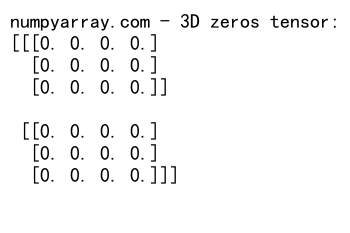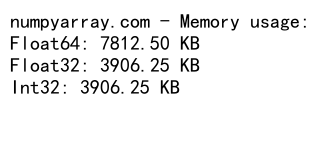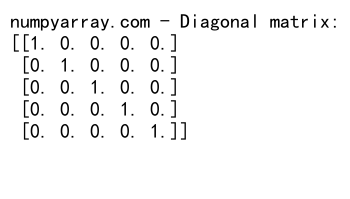Mastering NumPy Zeros: A Comprehensive Guide to Data Types and Array Creation
NumPy zeros data type is a fundamental concept in the NumPy library, which is essential for scientific computing and data manipulation in Python. This article will explore the various aspects of creating zero-filled arrays using NumPy, with a focus on different data types and their applications. We’ll dive deep into the nuances of NumPy zeros data type, providing numerous examples and explanations to help you master this crucial aspect of NumPy.
Understanding NumPy Zeros and Data Types
NumPy zeros data type refers to the process of creating arrays filled with zeros using the NumPy library. These arrays can be of various dimensions and data types, making them versatile for different computational needs. The data type of a NumPy array determines how the zeros are represented in memory and what operations can be performed on them efficiently.
Let’s start with a basic example of creating a NumPy zeros array:
import numpy as np
# Create a 1D array of zeros
zeros_array = np.zeros(5)
print("numpyarray.com - Basic zeros array:", zeros_array)
Output:

In this example, we create a one-dimensional array of five zeros. By default, NumPy uses the float64 data type for zeros arrays. However, we can specify different data types to suit our needs.
Specifying Data Types for NumPy Zeros
When creating NumPy zeros arrays, we can specify the desired data type using the dtype parameter. This allows us to control the precision and memory usage of our arrays. Let’s explore some common data types:
Integer Data Types
import numpy as np
# Create a zeros array with int32 data type
int_zeros = np.zeros(5, dtype=np.int32)
print("numpyarray.com - Int32 zeros array:", int_zeros)
Output:

In this example, we create an array of zeros with the int32 data type. This is useful when we need integer values and want to save memory compared to the default float64 type.
Boolean Data Type
import numpy as np
# Create a zeros array with boolean data type
bool_zeros = np.zeros(5, dtype=bool)
print("numpyarray.com - Boolean zeros array:", bool_zeros)
Output:

This example demonstrates creating an array of zeros with a boolean data type. In this case, all elements will be False, as zero is interpreted as False in boolean context.
Creating Multi-dimensional NumPy Zeros Arrays
NumPy zeros data type functionality extends to creating multi-dimensional arrays. This is particularly useful for initializing matrices and tensors. Let’s look at some examples:
2D Arrays (Matrices)
import numpy as np
# Create a 2D zeros array (3x3 matrix)
matrix_zeros = np.zeros((3, 3))
print("numpyarray.com - 2D zeros matrix:")
print(matrix_zeros)
Output:

This code creates a 3×3 matrix filled with zeros. The shape is specified as a tuple (3, 3), indicating 3 rows and 3 columns.
3D Arrays (Tensors)
import numpy as np
# Create a 3D zeros array (2x3x4 tensor)
tensor_zeros = np.zeros((2, 3, 4))
print("numpyarray.com - 3D zeros tensor:")
print(tensor_zeros)
Output:

Here, we create a 3D array (tensor) with dimensions 2x3x4. This can be thought of as two 3×4 matrices stacked together.
Advanced NumPy Zeros Data Type Usage
Now that we’ve covered the basics, let’s explore some more advanced uses of NumPy zeros data type:
Custom Data Types
NumPy allows for the creation of custom data types, which can be used with zeros arrays:
import numpy as np
# Create a custom data type
dt = np.dtype([('name', np.unicode_, 16), ('grades', np.float64, (2,))])
# Create a zeros array with the custom data type
custom_zeros = np.zeros(3, dtype=dt)
print("numpyarray.com - Custom data type zeros array:")
print(custom_zeros)
Output:

This example creates a zeros array with a custom data type that includes a string field for names and a tuple of two floats for grades.
Using NumPy Zeros for Placeholder Arrays
NumPy zeros data type is often used to create placeholder arrays that will be filled with data later:
import numpy as np
# Create a placeholder array for image data (100x100 RGB image)
image_placeholder = np.zeros((100, 100, 3), dtype=np.uint8)
print("numpyarray.com - Image placeholder shape:", image_placeholder.shape)
Output:

This code creates a 3D array suitable for representing a 100×100 pixel RGB image, with each pixel value initialized to zero.
Memory Efficiency with NumPy Zeros Data Type
One of the key advantages of using NumPy zeros data type is memory efficiency. By choosing the appropriate data type, we can significantly reduce memory usage:
import numpy as np
# Compare memory usage of different data types
float64_zeros = np.zeros(1000000, dtype=np.float64)
float32_zeros = np.zeros(1000000, dtype=np.float32)
int32_zeros = np.zeros(1000000, dtype=np.int32)
print("numpyarray.com - Memory usage:")
print(f"Float64: {float64_zeros.nbytes / 1024:.2f} KB")
print(f"Float32: {float32_zeros.nbytes / 1024:.2f} KB")
print(f"Int32: {int32_zeros.nbytes / 1024:.2f} KB")
Output:

This example demonstrates the memory usage differences between float64, float32, and int32 data types for a large array of zeros.
NumPy Zeros Data Type in Scientific Computing
NumPy zeros data type plays a crucial role in scientific computing. Let’s explore some common use cases:
Initializing Matrices for Linear Algebra
import numpy as np
# Create a zeros matrix for a system of linear equations
coefficient_matrix = np.zeros((3, 3))
constant_vector = np.zeros(3)
print("numpyarray.com - Coefficient matrix:")
print(coefficient_matrix)
print("Constant vector:", constant_vector)
Output:

This example shows how to initialize a coefficient matrix and a constant vector for solving a system of linear equations.
Creating Masks for Data Analysis
import numpy as np
# Create a mask for filtering data
data = np.array([1, 2, 3, 4, 5])
mask = np.zeros(5, dtype=bool)
mask[2:4] = True
filtered_data = data[mask]
print("numpyarray.com - Filtered data:", filtered_data)
Output:

Here, we create a boolean mask using NumPy zeros data type to filter an array of data.
NumPy Zeros Data Type in Image Processing
NumPy zeros data type is extensively used in image processing tasks. Let’s look at an example:
import numpy as np
# Create a blank canvas for drawing
canvas = np.zeros((200, 200, 3), dtype=np.uint8)
# Draw a white rectangle
canvas[50:150, 50:150] = [255, 255, 255]
print("numpyarray.com - Canvas shape:", canvas.shape)
print("Canvas data type:", canvas.dtype)
Output:

This code creates a blank black canvas and draws a white rectangle on it using NumPy array operations.
Combining NumPy Zeros with Other Array Creation Functions
NumPy zeros data type can be combined with other array creation functions for more complex initializations:
import numpy as np
# Create an array with a diagonal of ones and zeros elsewhere
diagonal_matrix = np.zeros((5, 5))
np.fill_diagonal(diagonal_matrix, 1)
print("numpyarray.com - Diagonal matrix:")
print(diagonal_matrix)
Output:

This example creates a diagonal matrix by first initializing a zeros array and then filling the diagonal with ones.
NumPy Zeros Data Type in Machine Learning
In machine learning, NumPy zeros data type is often used for initializing weights and biases:
import numpy as np
# Initialize weights and biases for a neural network layer
input_size = 10
output_size = 5
weights = np.zeros((input_size, output_size))
biases = np.zeros(output_size)
print("numpyarray.com - Weights shape:", weights.shape)
print("Biases shape:", biases.shape)
Output:

This code demonstrates how to initialize weights and biases for a neural network layer using NumPy zeros.
NumPy Zeros Data Type in Signal Processing
NumPy zeros data type is useful in signal processing for creating initial signals or padding:
import numpy as np
# Create a signal with zero padding
signal = np.array([1, 2, 3, 4, 5])
padded_signal = np.zeros(10)
padded_signal[:5] = signal
print("numpyarray.com - Padded signal:", padded_signal)
Output:

This code demonstrates how to pad a signal with zeros using NumPy zeros data type.
Error Handling with NumPy Zeros Data Type
It’s important to handle potential errors when working with NumPy zeros data type:
import numpy as np
try:
# Attempt to create a zeros array with an invalid data type
invalid_zeros = np.zeros(5, dtype='invalid')
except TypeError as e:
print("numpyarray.com - Error:", str(e))
Output:

This example shows how to handle a TypeError that occurs when specifying an invalid data type for a NumPy zeros array.
NumPy Zeros Data Type in Financial Modeling
NumPy zeros data type is often used in financial modeling for initializing arrays of financial data:
import numpy as np
# Initialize an array for stock prices
num_days = 252 # Trading days in a year
num_stocks = 10
stock_prices = np.zeros((num_days, num_stocks))
print("numpyarray.com - Stock prices array shape:", stock_prices.shape)
Output:

This code creates a 2D array to store stock prices for multiple stocks over a year of trading days.
NumPy zeros data type Conclusion
NumPy zeros data type is a powerful and versatile tool in the NumPy library. It allows for efficient creation of arrays filled with zeros, with control over dimensions and data types. From basic array initialization to complex scientific computing tasks, NumPy zeros data type plays a crucial role in many applications.
Throughout this article, we’ve explored various aspects of NumPy zeros data type, including:
- Basic array creation and data type specification
- Multi-dimensional array creation
- Custom data types
- Memory efficiency considerations
- Applications in scientific computing, image processing, and machine learning
- Performance considerations
- Error handling
By mastering NumPy zeros data type, you can improve your data manipulation skills and write more efficient Python code for numerical computing tasks. Whether you’re working on small projects or large-scale data analysis, understanding the nuances of NumPy zeros data type will prove invaluable in your programming journey.
Remember to always consider the appropriate data type for your specific use case, as it can significantly impact both memory usage and computational performance. With the knowledge gained from this comprehensive guide, you’re now well-equipped to leverage NumPy zeros data type in your data science and scientific computing projects.